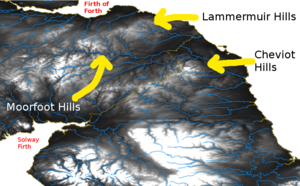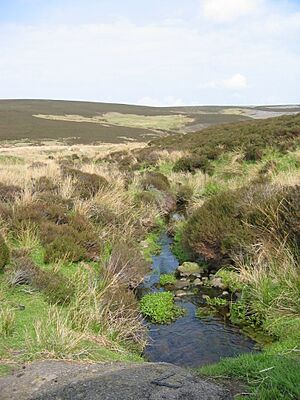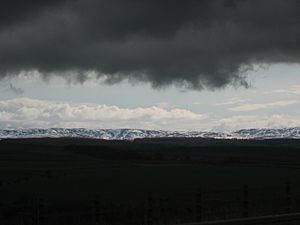Lammermuir Hills facts for kids
The Lammermuirs (also called An Lomair Mòr in Scottish Gaelic) are a group of hills in southern Scotland. They create a natural border between East Lothian and the Borders region. These hills are known for their beautiful landscapes and are a popular spot for sheep grazing.
Contents
What's in a Name?
The name "Lammermuirs" might come from old words. One idea is that it means 'lambs' moor', combining the Old English words lambra (lambs) and mor (moor).
Another idea is that the name comes from Gaelic. It could be from lann barra mor, which means 'level spot on the big height'. Over time, the name has been spelled in different ways, like Lombormore and Lambremore.
How the Hills Were Formed
The Lammermuir Hills are made mostly of old rocks called greywackes. These rocks formed from sand and mud at the bottom of the sea a very long time ago, during the Silurian and Ordovician periods. You can also find siltstones, shales, and mudstones here.
Later, other rocks formed on top of these older layers. These include coarse red-purple rocks called conglomerates. You can see these rocks in the eastern parts of the hills and near places like Soutra Hill.
There are also many dykes in the area. These are like walls of rock that formed when molten rock pushed up through cracks in the Earth. A large mass of granite rock, called the Priestlaw Intrusion, is also found near the Whiteadder Reservoir.
During the Ice Age, glaciers shaped the land. You can still see channels carved by melting ice along the edges of the hills, especially near Gifford.
Exploring the Lammermuirs
The Lammermuirs stretch across several counties, including Selkirk, East Lothian, and Berwick. They go from the Gala Water all the way to St Abb's Head on the coast.
These hills are not super tall, but they can be quite steep. The highest points are Meikle Says Law at 535 meters (1,755 feet) and Lammer Law at 528 meters (1,732 feet). Because of their steepness and the weather, it can be hard to travel across them.
Only one main road, the A68, crosses the hills. It goes over Soutra Hill between Lauder and Pathhead. This road often closes in winter because of snow. The main road connecting Edinburgh to England, the A1, goes around the hills along the coast to avoid them.
Interesting Places and History
- White Castle: This was an Iron Age hill fort located in the Lammermuirs. It was once home to the ancestors of the Votadini tribe.
- Crystal Rig Wind Farm: This large wind farm, with many wind turbines, is located on the hills and generates electricity.
The Lammermuirs have also played a part in history and literature:
- Saint Cuthbert: A famous missionary bishop from Northumbria spent his younger years as a shepherd on these very hills.
- Literature: The famous Scottish writer Sir Walter Scott set his novel The Bride of Lammermoor here. This book later inspired the opera Lucia di Lammermoor by Gaetano Donizetti.
Did you know there are other places named after these hills? Two ranges of hills in New Zealand, the Lammermoors and Lammerlaws, were named after the Scottish Lammermuir Hills.




